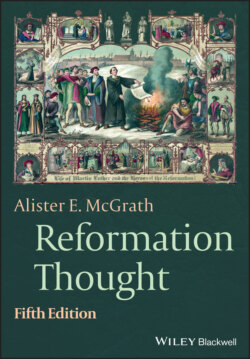Читать книгу Reformation Thought - Alister E. McGrath - Страница 32
Sacralizing the Secular: Christianity as a World-Engaging Faith
ОглавлениеRecent studies have noted how most of the intellectual and spiritual leaders of medieval Christianity were monastic, isolated from many of the harsher realities of everyday life by the walls of their monasteries and convents. Although there is ample evidence that what could be considered to be “evangelical” modes of thought arose within some of the monasteries of northern Italy in response to a growing interest in the spirituality of Paul’s letters in the final decade of the fifteenth century, it is important to note that Protestantism’s early cultural habitat was the world of European cities and marketplaces, exposing its thinkers to pressures and problems that their Catholic forebears had not been required to consider. The intellectual leaders of the first phase of Protestantism – such as Martin Luther, Huldrych Zwingli, Martin Bucer, Heinrich Bullinger, and John Calvin – developed both their reforming programs and their understanding of how Christians related to the world within an urban context.
Yet the transition from the monastery to marketplace exposed these reforming movements to precisely the dangers, threats, and problems that had led to the emergence of the monastic movement in the first place. Monasticism recognized the dangers of contamination of faith by political power, financial privilege, and being part of the cultural establishment. Monasticism withdrew from the world, in order to maintain its spiritual and religious purity. So how could the urbanized forms of Christianity that emerged from the Reformation maintain their spiritual integrity, when they existed in such a close relationship with the power structures of the imperial cities?
The negotiation of the boundaries between the spiritual and secular became an increasingly important theme in the forms of spirituality that emerged from the reforming movements in Germany and Switzerland. This contrasted sharply with the dominant themes of medieval spirituality. In some ways, the movement generally known as the Devotio Moderna (“Modern Devotion”) can be seen as anticipating themes later linked with the Reformation, such as the affirmation of the spiritual importance of the laity. Perhaps the most famous work to emerge from this school is Thomas à Kempis’ De imitatione Christi, written around 1425. The full title of this work, in English, is On the Imitation of Christ and Contempt for the World. A positive response to Jesus Christ is here presented as entailing a negative response to the world. For à Kempis, cultivating a detached or negative attitude toward the world was a mark of spiritual maturity and a precondition for spiritual growth. To “take up the cross” was to renounce the world.
The forms of spirituality which emerged from reforming movements in Germany and Switzerland had little sympathy for such an ethos of disconnection and detachment. Despite divergences on points of detail, Luther and Calvin insisted that Christianity belonged in the everyday world; there was no sound theological basis for a distinction between the “spiritual” and “temporal” realms (see p. 183). All Christians are called to be priests, and that calling extends to the everyday world. They are called to purify and sanctify its everyday life from within. Luther stated this point succinctly: “What seem to be secular works are actually the praise of God and represent an obedience which is well pleasing to him.”
This is often presented as a secularization of the sacred; while there is some truth in this, it is important to realize that early reforming writers saw this more in terms of the sacralization of the everyday world, in that activities traditionally regarded as lacking any spiritual role or significance came to be invested with religious value. The Protestant work ethic, now too often misunderstood simply as the affirmation of the value of productive labor, was more fundamentally about the discernment of the spiritual value of working in the home and the world, which was often framed as a form of worship and witness.
This point is brought out clearly by the English Protestant poet George Herbert in the early seventeenth century. Herbert is noted for his ability to transpose the leading themes of the Protestant reformation into poetic diction. For Herbert, the performance of even a menial action in the service of God endows it with significance and value.4
A servant with this clause
Makes drudgery divine:
Who sweeps a room as for Thy laws,
Makes that and the action fine.
The key point here is that the Reformation articulated a way of thinking – and consequently a way of living – which affirmed the importance of everyday life, turning what might be seen as the mundane into acts of service and witness.
Up to this point, we have focused on some positive aspects of the new ways of thinking – which Luther and Calvin carefully depicted as a recovery of older and more authentic ways of thinking – introduced by the Reformation. We now turn to consider an aspect of late medieval religious culture which prepared the way for the Reformation in a more negative way. In what follows, we shall consider the widespread confusion at this time about what the church actually taught about certain questions – including the issue of what was required in order to be saved.
